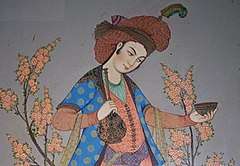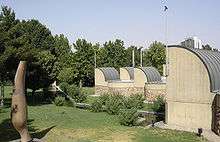Iranian modern and contemporary art
 | ||||||||||||||
| History of Persian Art | ||||||||||||||
|---|---|---|---|---|---|---|---|---|---|---|---|---|---|---|
| ||||||||||||||
A cursory glance at the history of art reveals that social, political and economic conditions have always played a major role in the emergence of new artistic currents and styles. In Iran, the social and political developments of the 1940s radically altered the evolution of this country’s plastic arts and entirely altering its natural path.
History
The modern art movement in Iran had its genesis in the late 1940s and early 1950s. This was the period after the death of famous Persian painter, Kamal-ol-molk (1852–1940) and thus symbolically the end of a rigid adherence to academic painting.[1]
The 1949 opening of the Apadana gallery in Tehran by Mahmoud Javadipour and other colleagues, and the emergence of artists like Marcos Grigorian in the 1950s, signaled a commitment to the creation of a form of modern art grounded in Iran.[2] Grigorian found influence for his art in popular Iranian culture, specifically a coffee-house storyteller culture and the visual language of dry earth and mud.[1] One of Grigorian's students at the College of Fine Arts at the University of Tehran was Hossein Zenderoudi, Zenderoudi was interested in the forms and aesthetics of objects made for Shi'a Islam worship.[1] The scholar Karim Emami likened his art to the kind of objects found in saqqakhanas, coining term, the "Saqqakhaneh school".[1][3]
Saqqakhaneh movement
In the 1950 and 1960s, a new subgenre of Iranian art called the Saqqakhaneh school (also known as Saqqā-ḵāna, Saqqa-khaneh, Saqakhaneh, Sahakhanah) was pioneered by artists Hossein Zenderoudi, Parviz Tanavoli, Faramarz Pilaram, Massoud Arabshahi, Mansur Qandriz, Nasser Oveisi, Sadeq Tabrizi and Zhazeh Tabatabai.[4][5]
Saqqakhaneh school is a movement of neo-traditional modern art that is found in Iran, rooted in a history of coffee-house paintings and Shiʿite Islam visual elements.[6][7][8] In scholar Karim Emami's articles on “Saqqā-ḵāna Paintings,” he defined in which a, "combined religious imagery and traditional decorative elements with modern painting techniques, played a significant role in drawing the attention of the media and art connoisseurs to the genre".[3] A visual language was created by drawing on the history of the Shi'a Islamic culture, specifically the saqqakhana, a small public area in which water is given to strangers often decorated with symbols and offerings.[9] The artists of this genre were re-appropriating these symbolic traditions associated with the saqqakhana but with a modernist stance.[9]
By the late 1960s into the 1970s he Saqqakhaneh school artists of Iran had international prominence and this helped pave the way for the opening of the Tehran Museum of Contemporary Art in 1977.[10] The Tehran Museum of Contemporary Art boasting an important collection of both Western and Iranian artists.[10] The Iranian revolution by 1979 halted the dynamics of the Iranian arts scene.[10]
It has been debated by various scholars after the publication of Edward Said's 1978 book Orientalism (which posed similar questions), was the Saqqakhaneh movement affected by the postcolonial view of Iran or rather, did it intensify Orientalism.[11][12]
Notable artists in Iranian modern art
Notable figures from the Iranian cultural continent

Iranian art is shared among people of Iranian cultural continent and is not limited to modern Iran. Modern art is emerging in Azerbaijan, Afghanistan, Tajikistan and Iraqi Kurdistan. In Afghanistan, Rahraw Omarzad, founded Center for Contemporary Art Afghanistan (CCAA) in 2004. A museum of modern art is under construction in Iraqi Kurdistan. Here is a list of notable figures of Iranian modern art throughout the Iranian cultural continent:
- Lida Abdul (Afghanistan)
- Sabzaly Sharif (Tajikistan)
- Mirshakarov Akmal (Tajikistan)
- Bekasien Anushervon (Tajikistan)
- Dilorom Shermatova (Tajikistan)
- Hamidova Nargis (Tajikistan)
See also
References
- 1 2 3 4 Sardar, Marika; Ekhtiar, Maryam (2004-10-01). "Modern and Contemporary Art in Iran". The Met’s Heilbrunn Timeline of Art History, The Metropolitan Museum of Art. Retrieved 2018-02-21.
- ↑ Article
- 1 2 "EMAMI, KARIM". Encyclopaedia Iranica. Retrieved 2018-02-21.
- ↑ "SAQQĀ-ḴĀNA SCHOOL OF ART". Encyclopaedia Iranica. Retrieved 2018-02-21.
- ↑ Rooney, Authors: Maryam Ekhtiar, Julia. "Artists of the Saqqakhana Movement (1950s–60s) | Essay | Heilbrunn Timeline of Art History | The Metropolitan Museum of Art". The Met’s Heilbrunn Timeline of Art History. Retrieved 2018-02-21.
- ↑ "Saqqakhaneh". art Circle. Retrieved 2018-02-21.
- ↑ "Saqqakhaneh art pieces showcased in Tehran". The Iran Project. Retrieved 2018-02-21.
- ↑ "Sadegh Tabrizi, founding member of Saqqakhaneh Movement/School". TabriziGalleries.com. Retrieved 2018-02-21.
- 1 2 Keshmirshekan, Hamid (2005-12-01). "Neo-traditionalism and modern Iranian painting: The Saqqa-khaneh school in the 1960s". Taylor and Francis. Iranian Studies, Volume 38, Number 4. Retrieved 2018-02-21.
- 1 2 3 Rooney, Authors: Maryam Ekhtiar, Julia. "Years Leading to the Iranian Revolution, 1960–79 | Essay | Heilbrunn Timeline of Art History | The Metropolitan Museum of Art". The Met’s Heilbrunn Timeline of Art History. Retrieved 2018-02-21.
- ↑ Khorshidian, Raika; Zahedi, Heidar (November 2017). "The Saqqa-khaneh School: Post-Colonialism or Orientalism Perspective?". The Scientific Journal of NAZAR research center (Nrc) for Art, Architecture & Urbanism. Volume 14, Number 53 – via ResearchGate.
- ↑ Keshmirshekan, Hamid (Summer 2010). "The Question of Identity vis-à-vis Exoticism in Contemporary Iranian Art". Iranian Studies. Volume 43, Number 4: 489–512 – via Taylor and Francis.